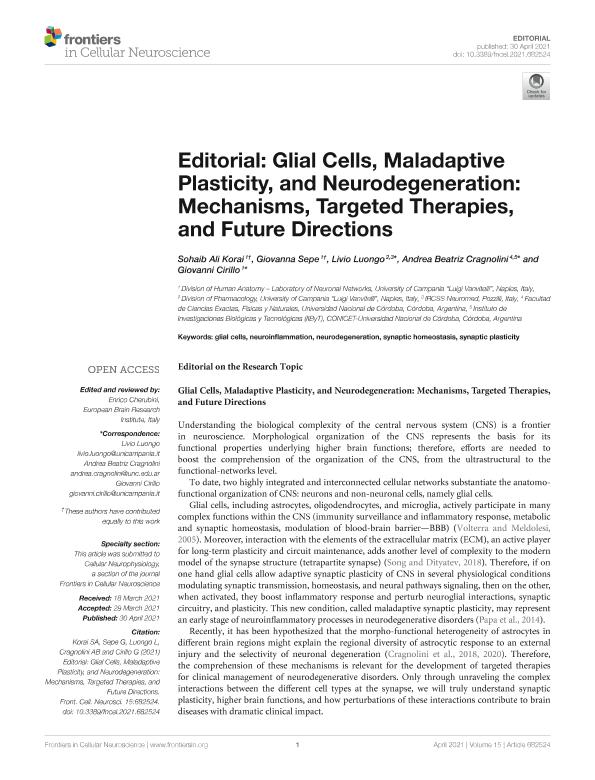Mostrar el registro sencillo del ítem
dc.contributor.author
Korai, Sohaib Ali
dc.contributor.author
Sepe, Giovanna
dc.contributor.author
Luongo, Livio
dc.contributor.author
Cragnolini, Andrea Beatriz

dc.contributor.author
Cirillo, Giovanni
dc.date.available
2021-07-30T17:57:43Z
dc.date.issued
2021-04-30
dc.identifier.citation
Korai, Sohaib Ali; Sepe, Giovanna; Luongo, Livio; Cragnolini, Andrea Beatriz; Cirillo, Giovanni; Editorial: Glial cells, maladaptive plasticity, and neurodegeneration: Mechanisms, targeted therapies, and future directions; Frontiers Media S.A.; Frontiers in Cellular Neuroscience; 15; 682524; 30-4-2021; 1-4
dc.identifier.issn
1662-5102
dc.identifier.uri
http://hdl.handle.net/11336/137487
dc.description.abstract
Understanding the biological complexity of the central nervous system (CNS) is a frontier in neuroscience. Morphological organization of the CNS represents the basis for its functional properties underlying higher brain functions; therefore, efforts are needed to boost the comprehension of the organization of the CNS, from the ultrastructural to the functional-networks level.To date, two highly integrated and interconnected cellular networks substantiate the anatomofunctional organization of CNS: neurons and non-neuronal cells, namely glial cells. Glial cells, including astrocytes, oligodendrocytes, and microglia, actively participate in many complex functions within the CNS (immunity surveillance and inflammatory response, metabolic and synaptic homeostasis, modulation of blood-brain barrier?BBB) (Volterra and Meldolesi, 2005). Moreover, interaction with the elements of the extracellular matrix (ECM), an active player for long-term plasticity and circuit maintenance, adds another level of complexity to the modern model of the synapse structure (tetrapartite synapse) (Song and Dityatev, 2018). Therefore, if on one hand glial cells allow adaptive synaptic plasticity of CNS in several physiological conditions modulating synaptic transmission, homeostasis, and neural pathways signaling, then on the other, when activated, they boost inflammatory response and perturb neuroglial interactions, synaptic circuitry, and plasticity. This new condition, called maladaptive synaptic plasticity, may represent an early stage of neuroinflammatory processes in neurodegenerative disorders (Papa et al., 2014). Recently, it has been hypothesized that the morpho-functional heterogeneity of astrocytes in different brain regions might explain the regional diversity of astrocytic response to an external injury and the selectivity of neuronal degeneration (Cragnolini et al., 2018, 2020). Therefore, the comprehension of these mechanisms is relevant for the development of targeted therapies for clinical management of neurodegenerative disorders. Only through unraveling the complex interactions between the different cell types at the synapse, we will truly understand synaptic plasticity, higher brain functions, and how perturbations of these interactions contribute to brain diseases with dramatic clinical impact.
dc.format
application/pdf
dc.language.iso
eng
dc.publisher
Frontiers Media S.A.

dc.rights
info:eu-repo/semantics/openAccess
dc.rights.uri
https://creativecommons.org/licenses/by-nc-sa/2.5/ar/
dc.subject
GLIAL CELLS
dc.subject
NEURODEGENERATION
dc.subject
NEUROINFLAMMATION
dc.subject
SYNAPTIC HOMEOSTASIS
dc.subject
SYNAPTIC PLASTICITY
dc.subject.classification
Otras Ciencias de la Salud

dc.subject.classification
Ciencias de la Salud

dc.subject.classification
CIENCIAS MÉDICAS Y DE LA SALUD

dc.title
Editorial: Glial cells, maladaptive plasticity, and neurodegeneration: Mechanisms, targeted therapies, and future directions
dc.type
info:eu-repo/semantics/article
dc.type
info:ar-repo/semantics/artículo
dc.type
info:eu-repo/semantics/publishedVersion
dc.date.updated
2021-07-29T13:53:10Z
dc.journal.volume
15
dc.journal.number
682524
dc.journal.pagination
1-4
dc.journal.pais
Suiza

dc.journal.ciudad
Lausana
dc.description.fil
Fil: Korai, Sohaib Ali. Università degli Studi della Campania "Luigi Vanvitelli"; Italia
dc.description.fil
Fil: Sepe, Giovanna. Università degli Studi della Campania "Luigi Vanvitelli"; Italia
dc.description.fil
Fil: Luongo, Livio. Università degli Studi della Campania "Luigi Vanvitelli"; Italia
dc.description.fil
Fil: Cragnolini, Andrea Beatriz. Consejo Nacional de Investigaciones Científicas y Técnicas. Centro Científico Tecnológico Conicet - Córdoba. Instituto de Investigaciones Biológicas y Tecnológicas. Universidad Nacional de Córdoba. Facultad de Ciencias Exactas, Físicas y Naturales. Instituto de Investigaciones Biológicas y Tecnológicas; Argentina
dc.description.fil
Fil: Cirillo, Giovanni. Università degli Studi della Campania "Luigi Vanvitelli"; Italia
dc.journal.title
Frontiers in Cellular Neuroscience
dc.relation.alternativeid
info:eu-repo/semantics/altIdentifier/url/https://www.frontiersin.org/articles/10.3389/fncel.2021.682524/full
dc.relation.alternativeid
info:eu-repo/semantics/altIdentifier/doi/https://doi.org/10.3389/fncel.2021.682524
Archivos asociados
